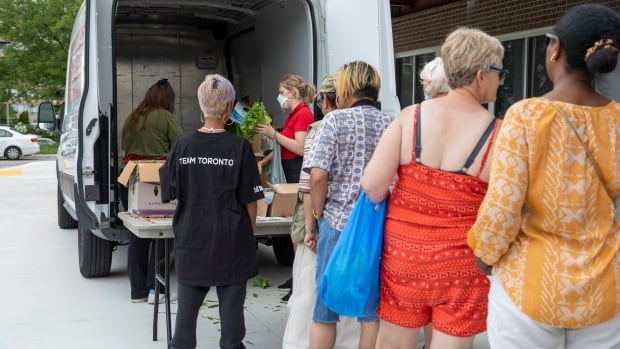
I'm in need of a food bank. What do I do?
CBC
This story idea came from audience members, like you, who got in touch with us. Send us all of your questions about food banks and food insecurity. We are listening: ask@cbc.ca.
Food bank usage in Canada is up. Way up.
In March of this year, there were nearly 1.5 million visits to food banks across the country, according to a recent report by the non-profit organization Food Banks Canada. That's 15 per cent higher than what was seen in March 2021, and 35 per cent higher than the number of visits in March 2019.
What's different about the rise in food bank use this year is that it comes as Canada's unemployment rate has seen a significant decrease. In March 2022, the country's unemployment rate sunk to 5.3 per cent — the lowest on record since data became available in 1976, according to Statistics Canada.
So what's behind the discrepancy? The Food Banks Canada report cites high inflation, stagnant social assistance rates and the surging cost of food and housing.
With more Canadians turning to food banks to feed themselves and their families, CBC News has also seen a significant number of audience questions about the resource: how to access one, give back to one — and what happens when donations aren't enough.
Food banks are scattered all across the country for Canadians who find themselves needing to put something on the table, but without the funds to do so.
If you're looking for one close to you, you can use Food Banks Canada's online locator and input your postal code.
Food banks are designed to help those in need, so they are offered free of charge.
However, who qualifies for access largely depends on which food bank you go to, explained Richard Matern, director of research at Food Banks Canada and author of the recently released report.
"Usually, there is some sort of intake process," he said, where an intake officer may ask you a range of questions, such as your name, address and source of income.
He encourages food bank visitors to bring a form of government ID and proof of address, if you have it, as you may be requested to provide them as part of that intake process.
Typically, food banks offer a wide variety of products, including non-perishables, fresh fruit and vegetables, and dairy products. Of course, depending on supply and demand, not all of those products may be available at the time of your visit.
Matern says food banks often distribute products to visitors in one of two ways. One model is via pre-packaged hampers, typically containing a selection of goods, which are given out when food banks are experiencing a busier period.

Canadian officials may have said they were caught off guard last week when U.S. President Donald Trump announced he was cutting off trade negotiations with Canada over Ontario's anti-tariff advertisement, but sources say Premier Doug Ford’s bad cop act— and tough words for Trump — has been an irritant.





















 Run 3 Space | Play Space Running Game
Run 3 Space | Play Space Running Game Traffic Jam 3D | Online Racing Game
Traffic Jam 3D | Online Racing Game Duck Hunt | Play Old Classic Game
Duck Hunt | Play Old Classic Game










